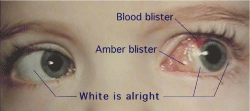Alaska Blind Child Discovery
A
cooperative, charitable research project to vision screen every preschool
Alaskan
Post-Op Strabismus
Home
Strabismus
is any condition in which the alignment of the eyes is not satisfactory.
Strabismus includes common conditions like ESOTROPIA (crossing) and EXOTROPIA
(drifting out or “walleye”). Other types of strabismus involve
vertical misalignment of the eyes, weakness of one or more of the six
muscles on each eye or restrictions in the movement of the eye. Surgery
is intended to realign the eyes, reduce restrictions and enhance power
in the direction of a weak muscle. Young children with strabismus are
at risk for AMBLYPOPIA (poor brain learning of vision). Older children
and adults may have double vision (DIPLOPIA) with strabismus. Some double
vision is often a part of recovery from strabismus
surgery; if this is very disturbing the first day or two, cover one
eye or the other.

The
extraocular muscles are covered with a thin layer of tissue called CONJUNCTIVA.
The surgeon approaches the muscle though holes or flaps in the conjunctiva.
Blood vessels under this tissue may leak during the procedure causing
a blood blister on the white of the eye or a drip of blood in the tears.
If the eye is very painful, or an infection occurs, then the normal blood
vessels in the conjunctiva become large and red; this helps you know whether
there is a problem after strabismus surgery.
ABCD History
Kids Eye Disorders
Amblyopia
Vision Screening
Issues
ABCD Clinics
References
Contact ABCD

Following general anesthesia for strabismus surgery, it is common to feel like a “hang-over.” There may be nausea, headache and sensitivity to light. Try to gradually resume fluids and then solid foods. If you frequently drink coffee or cola, taking some caffeine may make the headache better. A cool wet cloth over the eyes helps with comfort and sensitivity to light. The following medications can be taken for pain: acetaminophen, ibuprofen and/or a narcotic by mouth every 4 hours as needed. The following medications can be taken for nausea: phenergan administered every 6 hours as needed.
The eye muscles are sewn in place with special tiny blue sutures which dissolve in about 2-4 weeks. During healing, the eye may itch and develop an amber blister over the dissolving suture. It might be possible to see tiny sutures on or under the white of the eye near the operated muscle. If a muscle was moved back, there may be a blue-gray hollow area on the wall of the eye where the muscle used to be. If a muscle is pulled forward, there may be an extra bulge under the conjunctiva in that area. In the rare instance that a sutured muscle pulls loose from the eye, that eye will not be able to move in the direction of that muscle; if this suddenly happens call your doctor right away.
Doctors always take precautions to avoid infections, inflammation and excessive bleeding after surgery. Infection after strabismus surgery is fortunately very rare. Infection after strabismus surgery would cause increased pain, increased discharge, large red blood vessels in the conjunctiva 360° around the white of the eye and swelling of the eyelid; call your doctor right away if you suspect an infection. Since the muscles are outside the wall of the eye, infections and bleeding do not effect vision unless a thin area develops near one of the stitches. Call your doctor if you lose vision after strabismus surgery.
Certain activities may threaten the healing after strabismus surgery. Refrain from the following after..
Swimming 7days, Bathing and showering 1 days, heavy lifting 1 days. Adults may resume driving as soon as the next day, Resume normal work, school and/or play as tolerated within the next 1-7 days.
Strabismus surgery can be done under different types of anesthesia; numbing drops, a “novacaine” injection behind the eye or under general anesthesia (patient is asleep and feels no pain). After the surgery, the eyes feel pain of varying amounts, depending on the degree of manipulation and stretching of the tissues and the impact of the surgery and recovery on the clear front of the eye (cornea). Drops or ointment after strabismus surgery help promote comfortable healing and reduce inflammation and infection.
